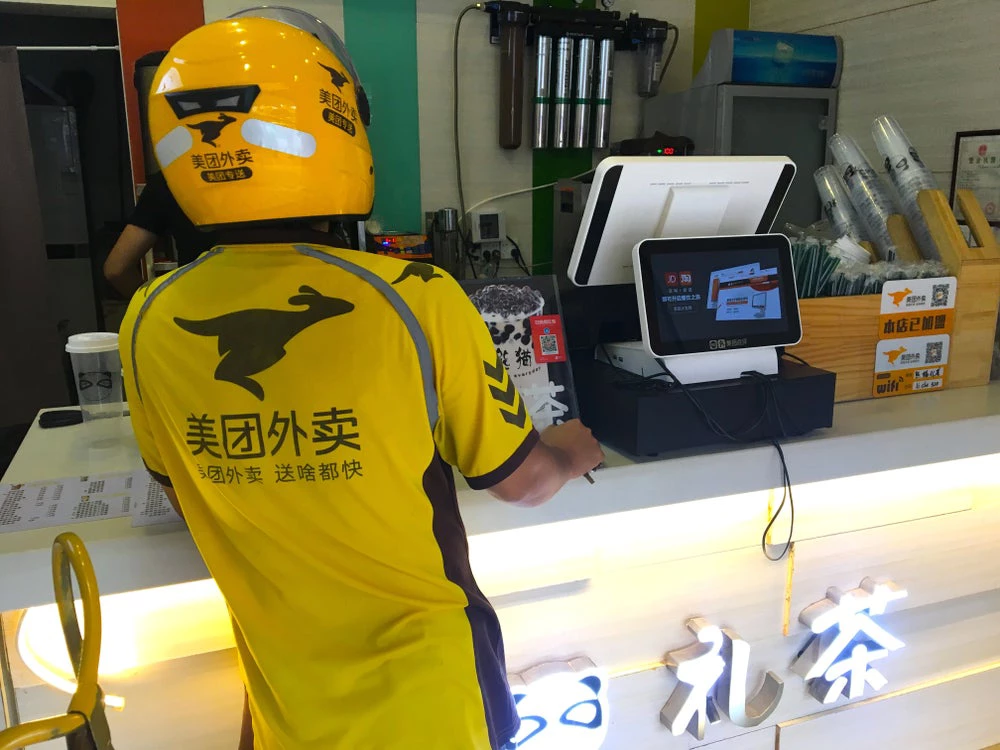 Food Delivery Service “Meituan Waimai” staff picking up products at cafe. Photo by: StreetVJ/Shutterstock
Food Delivery Service “Meituan Waimai” staff picking up products at cafe. Photo by: StreetVJ/Shutterstock
From social media, mobile payment, e-commerce to e-government, digital technologies have transformed the way people interact, businesses conduct commercial transactions and governments deliver public services in recent decades. Confronting the ongoing COVID-19 crisis, digital technologies have shown a great potential beyond improving convenience or efficiency, playing an indispensable role in sustaining social and economic activities. Challenges and risks also emerge in embracing various digital innovations.
First, digital platforms allow a smooth and rapid transition of tremendous offline undertakings to online activities. As mobility constraints intensify due to government orders or rising health concerns, digital platforms that support live-video communication offer solutions for seamless remote study or work. For instance, Lark, is providing free cloud storage and video conference services to individuals and institutions in India. Dingtalk, a communication platform that supports video conferencing and attendance tracking has connected more than 50 million students with teachers in China. The “scale without mass” feature of digital platform firms as mentioned in the World Development Report 2019, enables them to swiftly upgrade the computing algorithm and operating IT architecture to incorporate an increasing number of users within a short period of time.
Moreover, e-commerce, which has taken root in many countries, is gaining popularity during the crisis. E-commerce platforms in Southeast Asia such as Lazada, Tokopedia and Shopee have seen sales boost and an influx of new online merchants. Innovative ways to facilitate e-commerce have also emerged. Livestream e-commerce has become the go-to option for sellers and consumers in China during the pandemic. Salespeople start to engage with potential customers through livestreaming since they cannot conduct face-to-face product presentations as they used to do in brick-and-mortar stores. On Taobao.com, China’s largest B2C e-commerce platform, livestream e-commerce merchants increased by seven-fold in February. Augmented reality or virtual tools adopted by retailers such as Ikea or Wayfair are being used more often in introducing products to customers virtually.
Reliable, fast, and affordable fixed-line and mobile broadband connections is a prerequisite to exploit the above-mentioned digital innovations. However, there exists a wide digital divide across and within countries. Until 2018, in low income countries, the mobile cellular subscription rate is 66 per 100 inhabitants, and the fixed broadband connection rate is as low as 0.74 per 100 people, compared to 128 mobile cellular subscribers per 100 inhabitants and 33.6 fixed broadband subscribers per 100 inhabitants in developed countries. Those who are not digitally connected face severe difficulties in receiving the most updated public health information, conducting life activities virtually or exploiting new digital working opportunities. There is a significant gap, underscoring the urgency of digital infrastructure investments.
Second, gig work, a new work arrangement that utilizes digital platforms such as Grab, Upwork, and DoorDash to connect workers to employers and those posting tasks, has come into the spotlight during the crisis. As many people start to rely on online ordering for food or daily essentials, demand for delivery services is surging as observed in many food delivery platforms such as Grab Food in Southeast Asia. Meituan Waimai, a Chinese on-demand food-delivery platform connecting restaurants and customers, created more than 336,000 delivery job opportunities from the end of January to early March. The increasing demand for gig work offers an avenue for people to gain extra income to offset lost earnings. However, most of the gig workers do not have basic health or unemployment insurance which is often based on a formal employer-employee relationship. This requires a rethink of social protection, as pointed out in the World Development Report 2019. It’s worth noting that gig workers and freelancers are eligible for unemployment benefits under the recently adopted U.S. CARES Act, signaling an unprecedented step to include gig workers in the social safety net.
Third, governments are also leveraging digital technologies to combat the COVID-19 crisis. E-government practices such as filing taxes online or submitting business registration forms online, which are recognized as efficient administrative procedures by the Doing Business report, ensure the continued provision of public services. Korea and Singapore are using contact tracing to identify people who have contagion risks. Israel is using cellphone location data to retrace the movement of individuals who test positive for the virus. China is adopting a QR code, with colors of green, yellow and red indicating people’s health risks, to allow access to public transportation or workplaces for those who are considered low-risk. This aims to enable healthy people to move freely in order to minimize the negative impact on the economy, while ensuring that those who may have been exposed to the virus are in quarantine.
However, data privacy concerns are also rising as governments explore digital options to halt the spread of the virus. Some governments are revealing anonymized information about confirmed infection cases, such as the person’s workplace or normal commute route, as an alert to the public. Such detailed information increases the likelihood of making infected people identifiable, putting them at risk of social stigma. This calls for transparent and consistent rules and regulations on enabling data usage for public health purpose while safeguarding individual rights, which is a key aspect measured under the ongoing Digital Business Indicators initiative. Inspired by the Doing Business project, the Digital Business Indicators aims to develop a benchmarking tool to measure the extent to which countries’ laws and regulations, among other factors, help expand access to high quality and affordable internet; establish a competitive digital market; protect personal data; enable digital monetary transactions; facilitate the delivery of goods to consumers; and effectively tax digital businesses.


Join the Conversation